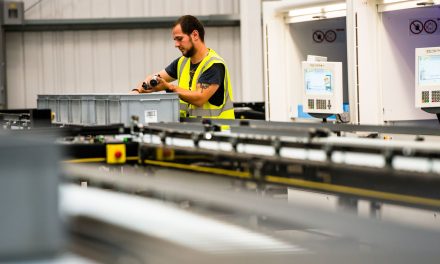
DCIM100MEDIADJI_0033.JPG
Julian Ware, UK & Ireland Sales Manager for ABB Robotics, explains how robotic automation is providing the answer to meeting the challenges and opportunities currently facing the retail and distribution value chain.
The last two years have been especially significant for the retail and logistics industries, with COVID-19 accelerating a transformation in consumer behaviours that was already in effect. In 2020, as lockdowns and social distancing rules restricted people from visiting shops, the level of goods purchased online increased exponentially, with e-commerce achieving in just 12 months a rate of growth originally projected to happen over five years. Statistics from Salesforce’s Shopping Index, for example, show that e-commerce grew by 47 percent in 2020, as more people went online to buy goods as shops closed due to lockdown restrictions. While many in the retail and distribution value chain had dreamed of such growth, few had the structures in place to achieve it, making it difficult to process and deliver the increased rate of orders or handle the greatly increased range of goods required.
 The shift to online shopping has also impacted on the availability of workforces to handle and despatch orders. In many cases, operators have struggled to match the increased demand for goods with workers, resulting in mass recruitment drives, such as Amazon’s hiring spree in 2020 to find 100,000 new staff to help it plug the gap in its headcount.
The shift to online shopping has also impacted on the availability of workforces to handle and despatch orders. In many cases, operators have struggled to match the increased demand for goods with workers, resulting in mass recruitment drives, such as Amazon’s hiring spree in 2020 to find 100,000 new staff to help it plug the gap in its headcount.
Another significant driver for change has been the growth of direct-to-consumer (D2C) and direct-to-store (D2S) shipping, which is dramatically changing the way that consumers order and collect products. With these new retail models, consumers have an expanding choice of methods for receiving orders in addition to home delivery, which is increasingly becoming environmentally and economically unsustainable as more people shop remotely. These methods include click and collect, in-store collection and, more recently, robotic street kiosks, where shoppers pay for and receive the products of their choice.
It is therefore no surprise that companies are looking to step up their adoption of automated solutions, combining the flexible and fast performance and handling capabilities of robots with AI and smart software systems that can help to better manage order handling and distribution.
 When it comes to addressing the increased demand for packaged goods of all shapes and sizes, robot manufacturers, including ABB, have been working to provide the solutions needed to get orders despatched quickly to consumers.
When it comes to addressing the increased demand for packaged goods of all shapes and sizes, robot manufacturers, including ABB, have been working to provide the solutions needed to get orders despatched quickly to consumers.
Greater flexibility
One challenge that has been solved by robotic automation is the need for flexible low volume, high mix package handling lines that can accommodate a range of different sized products in varying orientations. Designed for handling loads up to 10kg, ABB’s IRB 390 five axis FlexPacker™ robot, for example, allows parcels and packages to be picked from high-speed conveyors moving at up to 100 meters per minute and packed in either horizontal or vertical orientations into cases, trays, crates or other packaging formats.
Keeping up with consumers
Another factor affecting automated packaging lines is the trend towards smaller packages, especially in the food and drink industry, which demands faster packaging lines to cope with the increase in speed from handling smaller pack sizes. For packaging companies, this requires flexible packaging lines that can respond quickly to changing consumer trends without significant disruption caused by having to reconfigure them to handle the new products.
With the emergence of digital twin technology, these hurdles can be overcome. Digital twin software such as ABB’s PickMaster® Twin enables a virtual representation of packaging lines to be built which can be used to test different configurations to arrive at an optimum solution. With an intuitive interface and the ability to use the simulation to simultaneously configure the running production line, PickMaster Twin dramatically reduces disruption to throughput by shortening commissioning times and enabling changeovers to be easily carried out in minutes.
The trend towards varying pack sizes is also supported by developments in vision and motion tracking technology incorporated in robotic solutions such as the IRB 360 FlexPicker® Delta fast picking robot, which can track and pick objects up to 8kg at a rate of up to 100 picks per minute. Also available in a hygienic stainless-steel option, FlexPicker increases the possibilities for rapid handling and packing of an increased range of items in food and pharmaceutical production lines.
 Embrace change with confidence
Embrace change with confidence
Given the acceleration of change – and opportunities – in today’s operating environment due to the global pandemic as well as other factors like the ongoing growth of e-commerce and the emergence of empowered customers demanding a wider range of choices, it pays to have a packaging line that is ready for anything. Offering a fast, flexible and adaptable solution for handling an expanding range of products around the clock, robotic automation provides the answer to meeting the challenges of today’s retail and distribution environments.
To find out more about the robotic options available for logistics applications, visit https://new.abb.com/products/robotics/industries/logistics.




